Francesco Hayez’s Pontremoli is suspended in the dream of a romantic Middle Ages, the first of Italy, made of immaculate castles and knights, velvet-clad ladies and blazing armor. Hayez, however, had never been to Pontremoli. Or if he was sometimes ever in Pontremoli, he left no trace of it. Nonetheless, all he needed to invent the work that started Italian Romanticism was a suggestion, a note from an ancient chronicle, a side episode in the history of the fourteenth century, almost forgotten, but so evocative that it inspired him to create one of his most impactful masterpieces. The Pietro Rossi at Pontremoli, the canvas that Hayez executed in 1818, at the age of twenty-seven, is now fully accepted as the first fully Romantic painting to be executed under the Alps, and was immediately recognized even by his contemporaries. It was a work that had immediate and unexpected success, so much so that, even decades later, Hayez found himself replicating that resounding youthful success. Three autograph versions of it remain today, never brought together until now. And to arrive at an exhibition capable of gathering and exhibiting the three paintings together required the resourcefulness of the Municipality of Pontremoli, which worked for a long time to bring to Lunigiana all the paintings that Hayez dedicated to the Parma condottiero, and the foresight of the Pinacoteca di Brera, which launched a project, La Grande Brera in tour, to disseminate throughout the territory works removed in the past from their contexts and works that instead have a deep connection with the places that temporarily welcome them.
Not even Hayez’s paintings have ever been to Pontremoli. They were all born far from here, but it was here that the historical fact delivered to the immediacy of the canvas took place: thus the choice to elevate Pontremoli to an ideal place for the first comparison of the Pietro Rossi versions in an exhibition-dossier, curated by Valentina Ferrari, Paolo Lapi and Fernando Mazzocca, that reconstructs in detail the genesis of the three paintings and unveils further, in-depth readings, seems natural. Looking at the three paintings side by side, in the dark, one is persuaded that, more than the historical characters with their armor, their tights, their damask skirts, and their dismayed expressions, the real leading actor in all three versions is the scenic apparatus imagined by Hayez. The fairy tale Middle Ages, the Middle Ages for which it was necessary to invent an image that did not, in fact, exist at the time. It would then come to be said that there are two, the great merits that should be attributed to the young Venetian painter. The first: the intuition that the culturalhumus in which he had grown up, in his Venice, needed to be sprayed with new ideas. New ideas that, Fernando Mazzocca reconstructs in the catalog, Hayez must have found in an essay by the collector Andrea Majer(Della imitazione pittorica, della eccellenza delle opere di Tiziano e della vita di Tiziano scritto da Stefano Ticozzi), published in that same 1818, in which the primacy of nature over theidea, the recovery of Titian (seen as the highest model to strive for) and the painters of the fourteenth and fifteenth centuries, and the rejection of the belief that “Painting on a par with all the imitative arts can only by using perfectly beautiful objects fulfill its double office of moving and delighting, since we see the Painter achieve this intent even by means of ugly and sometimes deformed objects.” Twenty years before Antonio Bianchini wrote Del purismo nelle arti, twenty-five before Lorenzo Bartolini sculpted the Stele del gobbo. Hayez, partly out of his own interest and partly at the urging of Leopoldo Cicognara who was his main supporter at the time (and who had directed him), opened himself to those “new figurative horizons,” Mazzocca writes in the catalog of the Pontremoli exhibition, “determined by the consideration and appreciation of the so-called primitives.” We do not really know what other sources Hayez’s genius must have drawn on: most likely, he could not fail to take into account what was being done between Germany and Italy by the Nazarenes, whom the artist had met in Rome at the time of his study stay. The fact is that the recovery had to be total: it was not only a matter of attitudes and languages, but also of content. It was not just a matter of formally updating neoclassical conventions (right down to the format: with Pietro Rossi, Hayez had moved away from the monumental painting of neoclassical painting and had returned to a more restrained easel painting): it was a matter of opening Italian painting to new subjects. The second merit is the redemption of that historical episode at the time (and still today) unknown to most people, probably even to the Pontremolians themselves, which offered Hayez the possibility of inventing from scratch the iconography of a subject that had never before been frequented. An episode so unknown that Hayez had to come up with a very long title for his work when he first presented it at the Brera Exhibition of 1820. It seemed to be a description rather than a title: Pietro Rossi, lord of Parma, dispossessed of his dominions by the Scaligeri, lords of Verona, while being invited in the castle of Pontremoli, of which he stood as defender, to take command of the Venetian army, which was to move against his own enemies, is tearfully entreated by his wife and two daughters not to accept the undertaking.
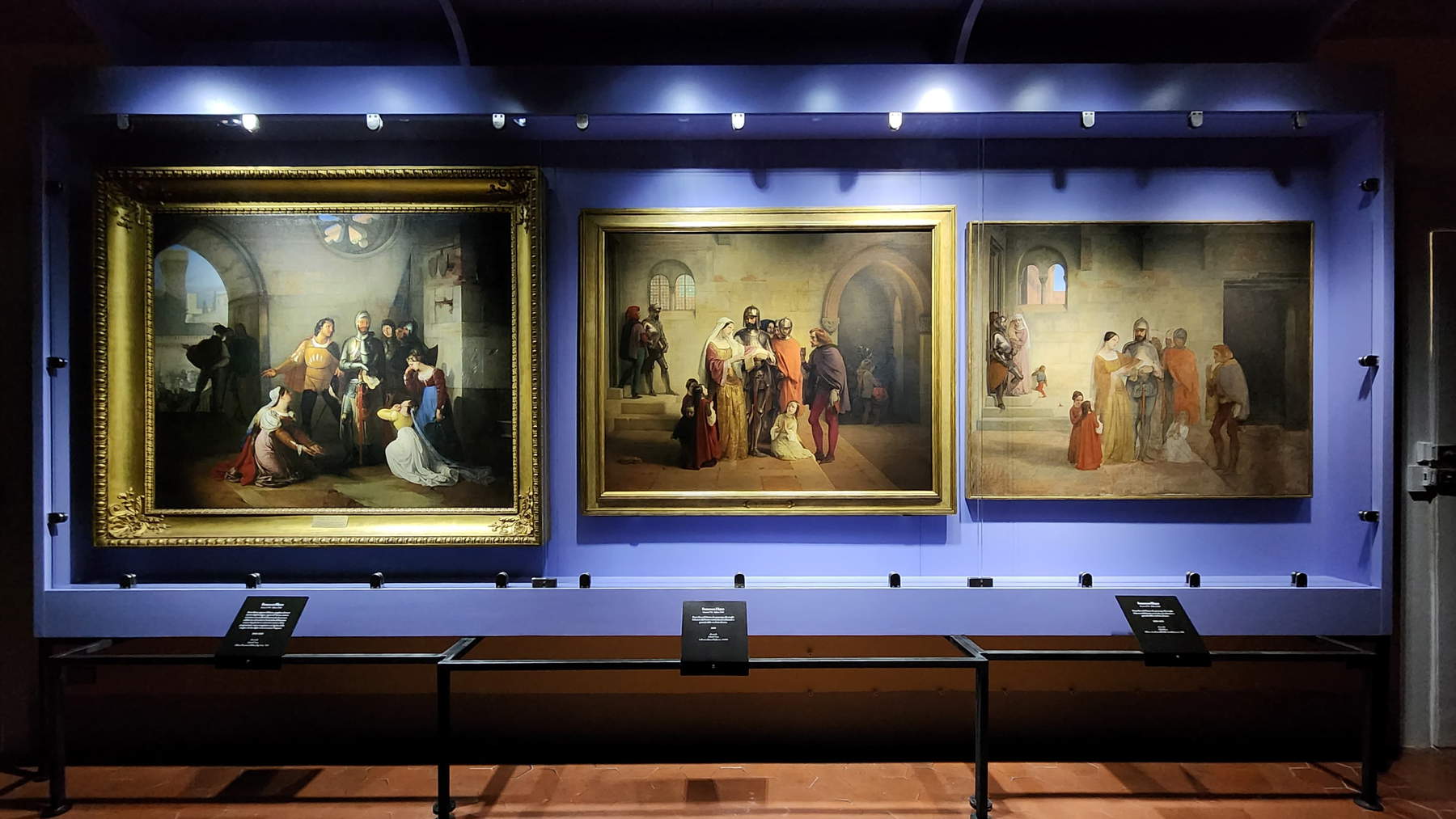
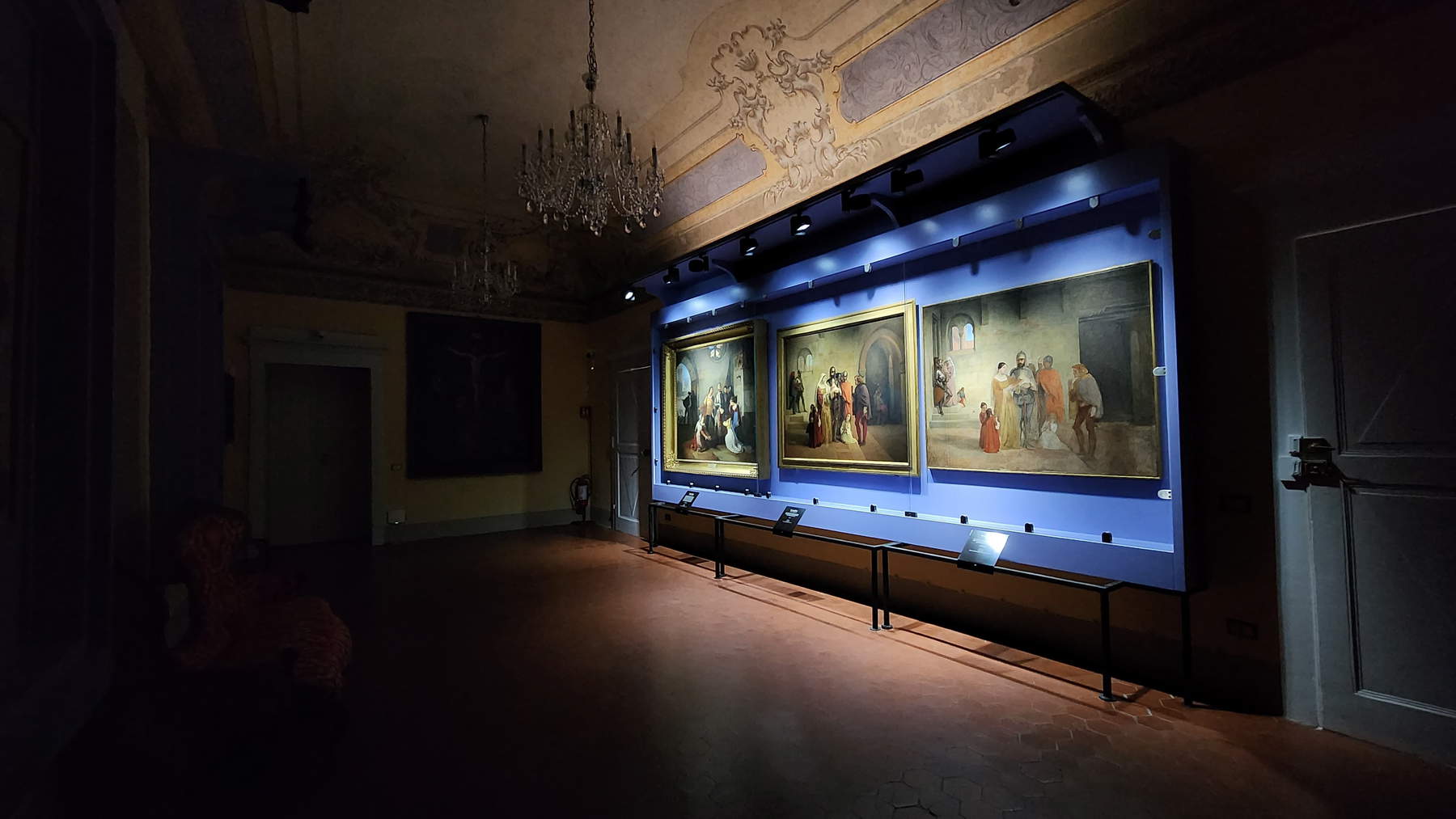
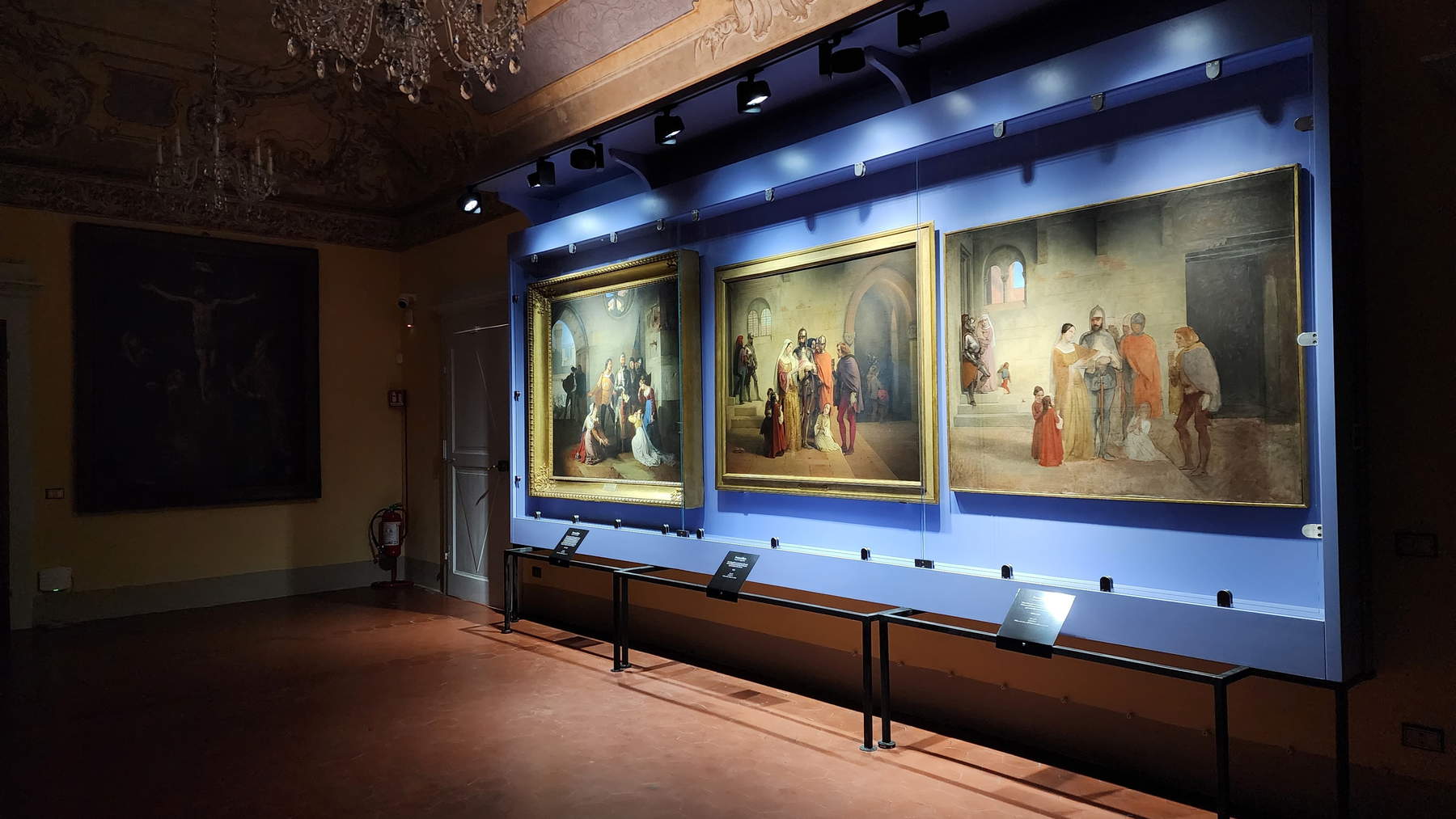
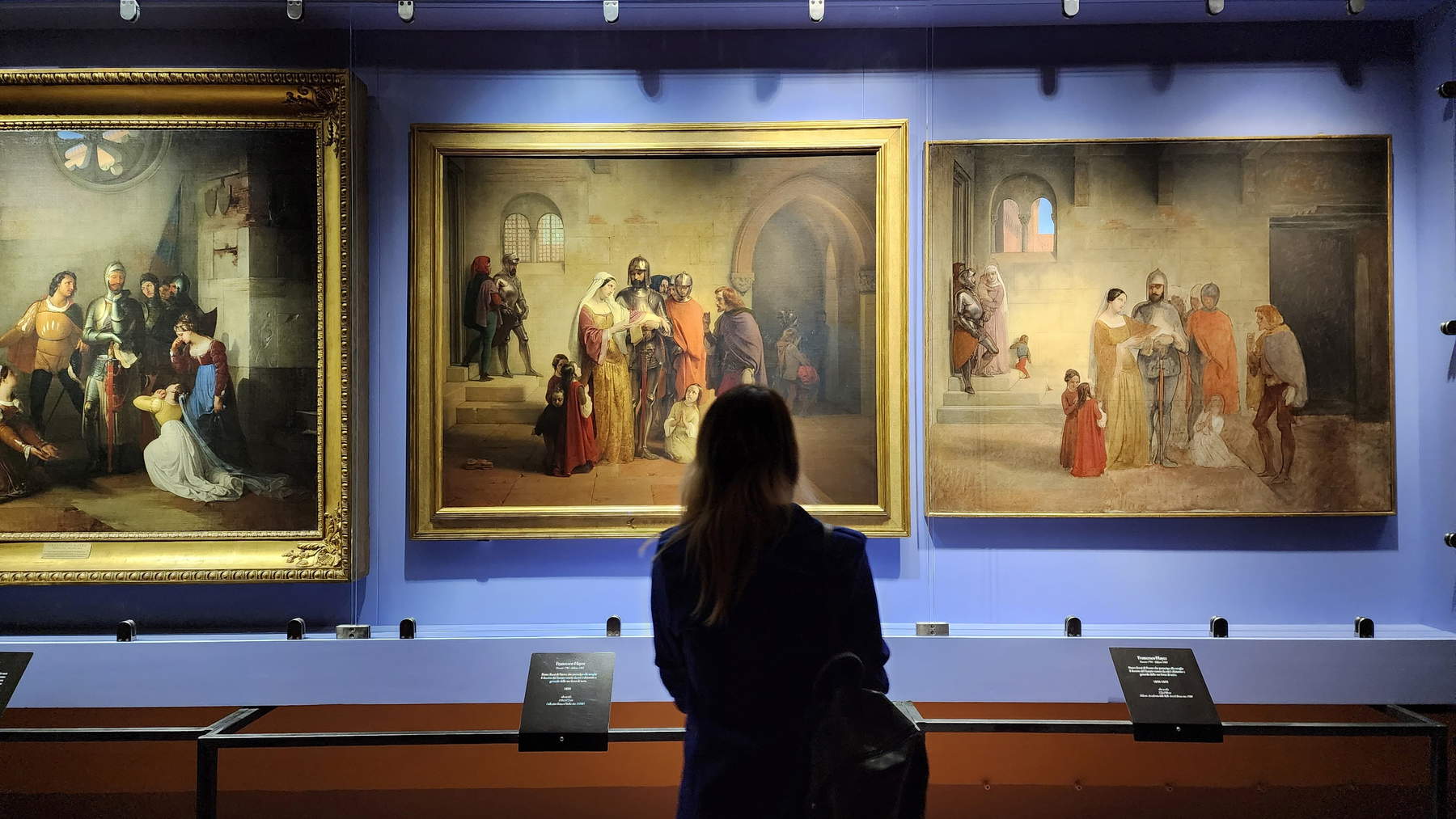
Hayez claimed to have derived the subject from a reading of his own, Jean Charles Léonard Simonde de Sismondi’s History of the Italian Republics of the Middle Centuries , which ended up being published precisely in 1818, but the’episode had already been addressed (and in more detail) by a publication forty years earlier, Marc-Antoine Laugier’sHistoire de la République de Venise , published in 1778 and later also edited in Venice: However, Laugier had relied on Marco Antonio Sabellico’s 1544 Historie vinitiane , which in turn drew from a chronicle of Venice written between 1421 and 1428 by the Venetian diplomat Lorenzo De Monacis. The episode is the siege of Pontremoli in 1336: the town, at the time ruled by Pietro Rossi, a member of one of the most distinguished noble families of Parma, had been attacked by the Veronese (despite the fact that the year before Verona had already obtained Parma and Lucca from the same Rossi), and the condottiero, while engaged in an attempt to repel the attackers, was reached by an ambassador of the Venetian Republic who asked him to ’assume command of the anti-scagliera league that the Serenissima itself had formed in order to contain the expansionist aims of the Veronese (the context is minutely reconstructed by Paolo Lapi in the exhibition catalog). Rossi, begged by his wife not to leave, would eventually accept Venice’s offer and leave Pontremoli.
The episode, even in its marginality, offered Hayez a content of very high symbolic value, since it would grant him the opportunity to grapple not so much with the historical theme itself, but rather on that “conflict between public duties and thematic affections,” as Valentina Ferrari effectively summarizes, which would become “the key that would make Hayez’s history painting truly relevant.” The painter, in all versions of the painting, focuses his attention on the moment of the Venetian ambassador’s arrival at the castle of Pontremoli (where “castle” is to be understood not so much as the Piagnaro Castle, also because in the 14th century the town was defended by three fortresses, two of which no longer exist today: the “castle” is, more extensively, the entire fortified village, the castrum that guarded one of the main communication routes between the north and south of the peninsula in medieval Italy): Hayez places the legate to the right of Pietro Rossi, depicted in a pensive pose, holding the dispatch from the Venetian Republic in one hand, and tries to give emphasis to the eloquent hand gesture inviting the condottiere to leave and take command of the Venetian army, while the women of the house (his wife on the left, kneeling with her hands outstretched in front of her, and his weeping daughters, on Pietro Rossi’s left) try to persuade the lord to stay. One of the daughters is even depicted from the back, an entirely unusual element for the time: Hayez wanted drama to be drawn from movement and gestures rather than expression.
The painter had studied the composition with supreme proficiency so that the contrast between duties and affections would emerge readily, and the success of his intent should be seen as underlying the positive opinions of the critics who had admired especially the attitude of the women of the Rossi household, although Hayez was convinced that the success was due above all to the intention of truth that he considered to be the foundation of his work: “this need for change,” he was to write in his memoirs, “was in me in the state of pure feeling, observing how art was stationary: therefore it begins by seeking the subject, by composing it in such a way that it had as much truth as possible, moving somewhat away from the overly pedantic rules that took life away from it, and much preserving the harmony of the lines of color, without calculating, even on this, the usual precepts.” And again, “I had as it were embodied in my work the idea which was dominant at that time, and which made so lively a controversy among the most distinguished literati, namely, the predominance of Romanticism over Classicism. These friends of mine believed that to have been my intention, but as I have already said I must confess that the change I introduced into the composition came to me from pure feeling for art, without any preconceived idea.” Indeed: today, more than two hundred years later, the intention of truth appears more solid to us in the exactness of the setting, which perhaps today attracts even more than the interplay of cross-references between the figures, and if there is a truth in the characters’ attitudes, perhaps that truth seems to us more a melodramatic truth, a theatrical truth theatrical truth, than a psychological truth or a historical truth, but by 1820, the year the painting was presented, this new truth of Hayez’s was more than enough to make the Brera audience wince, fully aware that the young Venetian, with his painting, had already broken the academic conventions of the time.
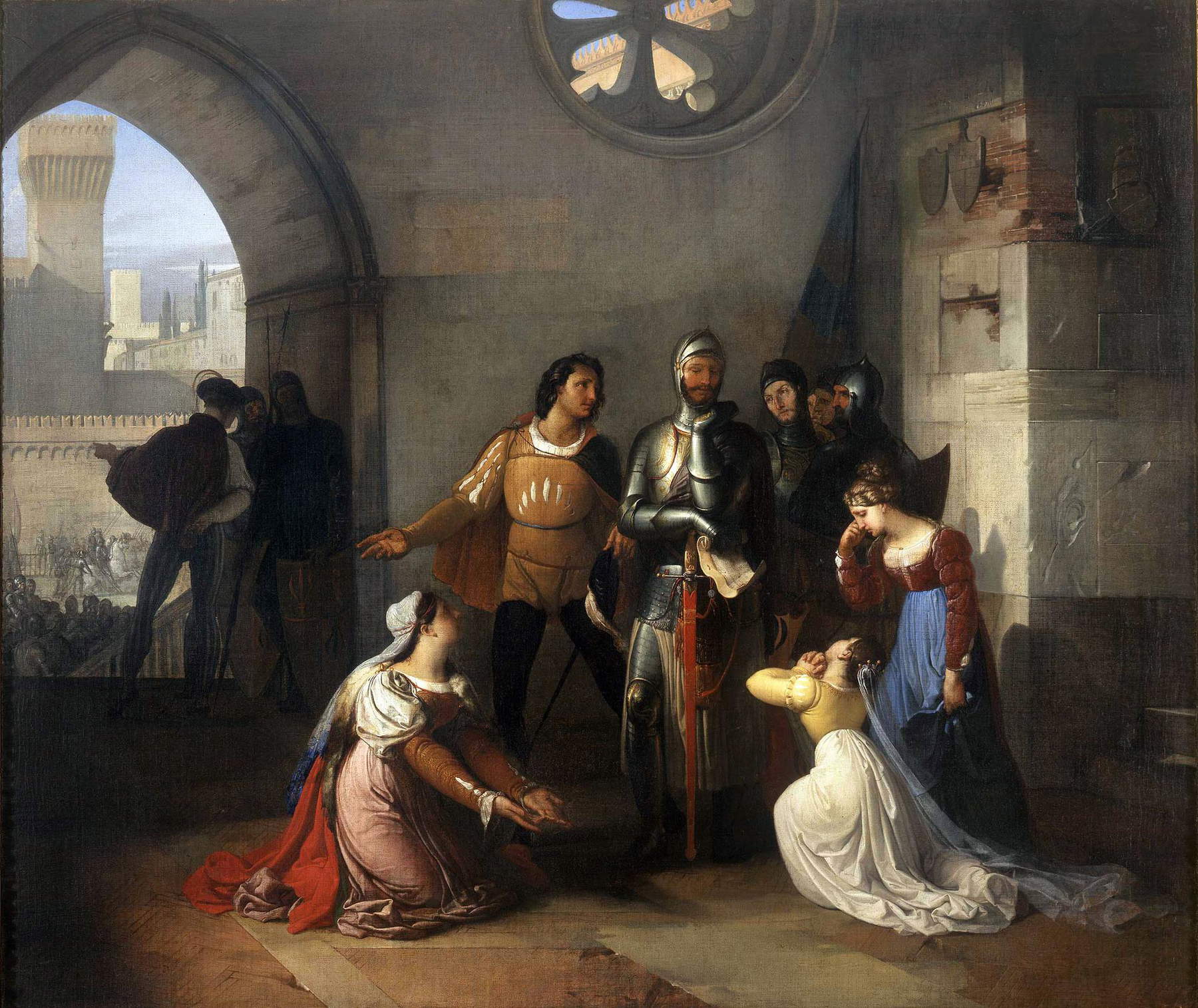
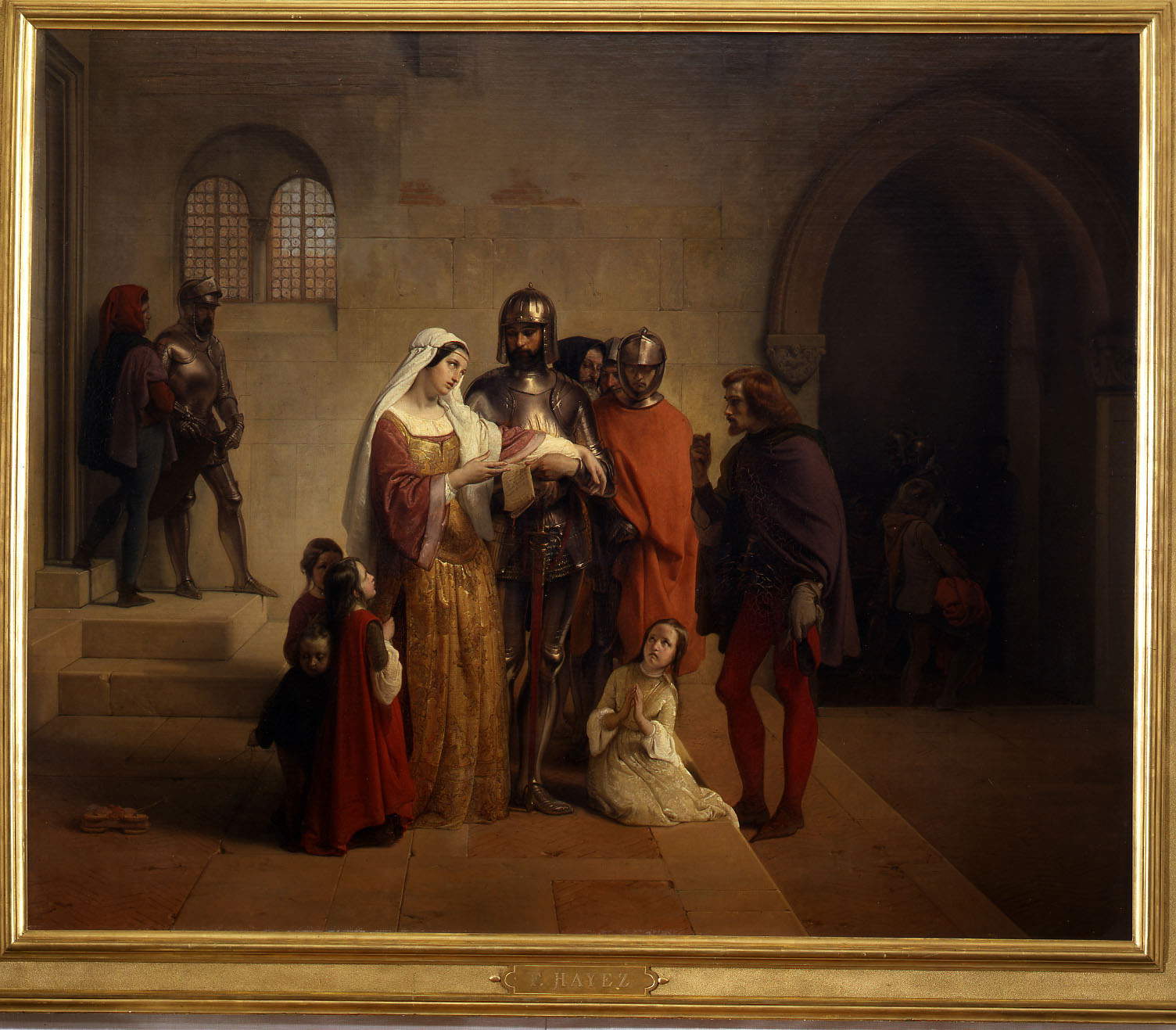
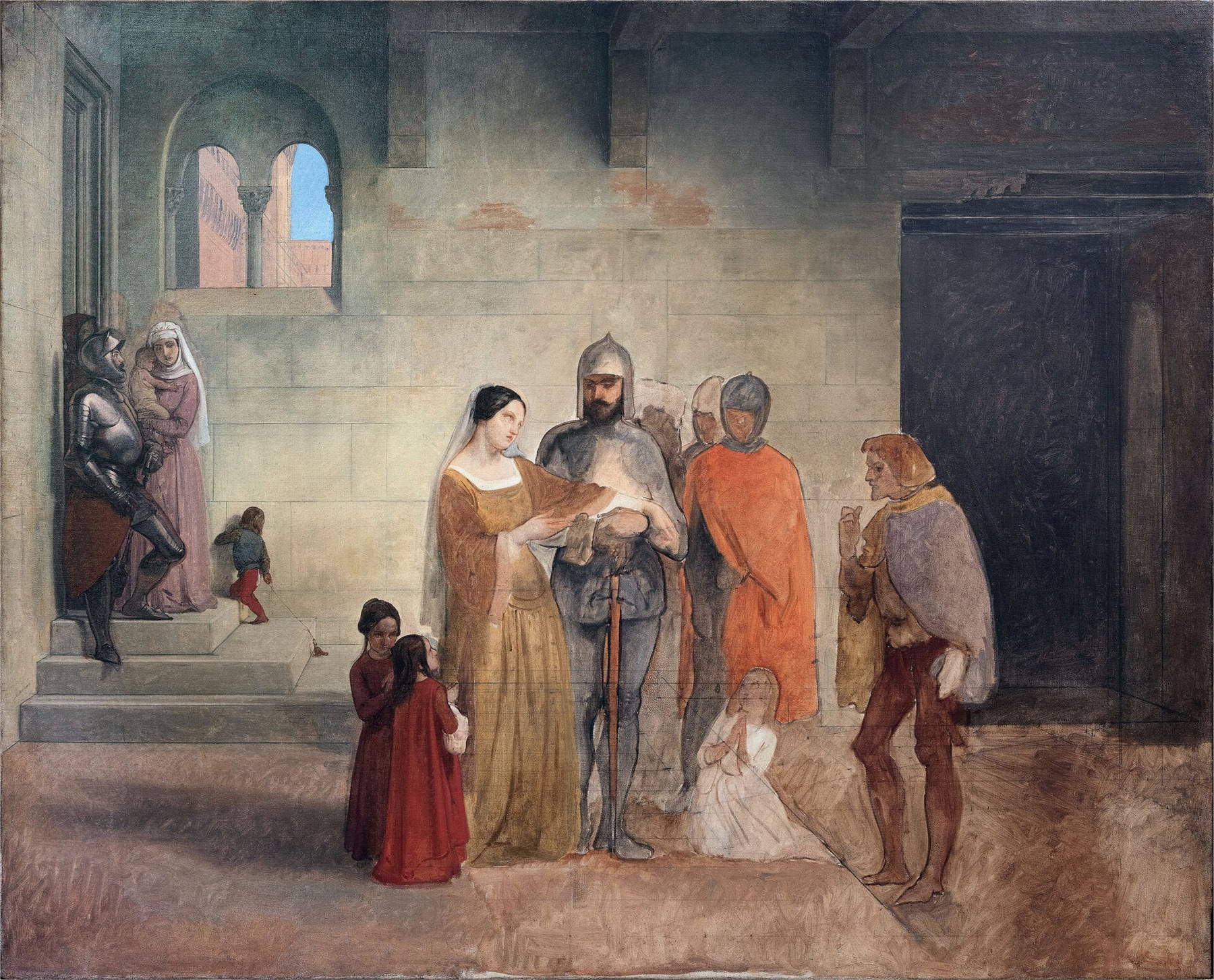
When the Pietro Rossi was exhibited in Milan, Milanese collectors fought over it: in the end, the work went to the young Giorgio Pallavicino Trivulzio (and the Milanese success, moreover, displeased Cicognara, who accused Hayez of not having been able “to resist the desire of those noble patrons who wanted to enrich theAccademia Milanese of its productions, and thus defrauded the Veneta, which remained with desire to applaud its own Concittadino, and invite him with a crown more to his luminous destiny.” Hayez demurred by saying that the Venetians, unlike the Milanese, were not interested in his paintings and would not let him work), while other collectors had to content themselves with ordering the painter new commissions with a historical theme. The next two paintings, which Hayez executed more than 30 years after the first Pietro Rossi, are further evidence of the long-lived fortune that befell his work. For Ferrari, however, the two versions of the 1950s must be placed in the strand of historical realism because of the obvious change in the painter’s attitude, who observes with greater acumen, greater finesse, greater psychological depth the looks, gestures, even the thoughts of the protagonists. The Venetian ambassador, for example: he is no longer the thespian of the 1818 painting, but is a character who approaches almost doubtfully, with a discreet manner, who seems almost as if he does not want to disturb and is a participant in the heartfelt moment, fully aware of the onerous commitment of Pietro Rossi, who is called upon to make a difficult decision. The wife no longer throws herself at her husband’s feet begging him not to leave, but approaches him looking sideways into his eyes, stands by his side, moves her fingers over the dispatch as if to express, at the same time, a feeling that lies somewhere between disbelief and disagreement, and with her left arm drooping over her husband’s it almost seems as if the painter wanted to convey the woman’s sense of dismay. The daughters are no longer the desperate teenagers of the 1818 painting, but are little girls clinging to their mother’s skirt: only one is kneeling to pray to her father, but without emphasis, with the spontaneity typical of childhood. And one of the sons, too young to understand what is happening, appears totally disinterested: in both paintings he is busy pulling a toy, a wooden toy car (although in the third, unfinished painting he has been moved to the background, to the scene of the soldier’s farewell to his family, inserted to amplify the central drama). An apparently insignificant element, but one that is instead fundamental to understanding the intent of sentimental and psychological credibility that animated Hayez thirty years after the founding manifesto of Romanticism.
Of course, the supreme novelty of the exhibition is, one might say, meta-textual, and lies in having juxtaposed three paintings, profoundly related to each other, which had never before been shown together and which allow us to appreciate, on the same wall, in a setting designed specifically to facilitate the reading of the three canvases together, the gradual shift in modes just mentioned: Hayez needed thirty years, but the Pontremoli audience can observe the outcome with a fulminating comparison. A comparison, it must be reiterated, not easy to put together for a town of not even ten thousand inhabitants, which nevertheless managed to obtain on loan one of the fundamental paintings of the modern collection of the Pinacoteca di Brera, one of the cornerstones of its collection, and the two companion works. A meritorious effort, both on the part of Pontremoli and of the Pinacoteca di Brera, which is starting from here, from Lunigiana, a diffusion project that therefore begins with the best auspices.
The juxtaposition of the three versions of the Pietro Rossi also provided an opportunity for a further reinterpretation of the subject in relation to the nascent Risorgimento impulses, also in consideration of the positive opinions of Mazzini who already in 1841 had found in Hayez “the head of the school of Historical Painting that national thought claimed in Italy, the most forward artist we know in the sentiment of the Ideal that is called to govern all the works of the age.” from the earliest Pietro Rossi, Mazzocca argues, "the patriotic message was entrusted to a very clear and shared call assigned to the right-hand figure of the weeping daughter, whose pose strikingly resembled that of the iconic weeping Italia in Vittorio Alfieri’s Funeral Monument erected by Canova in Santa Croce in Florence." An idea also shared by Valentina Ferrari who recalls the context of Carbonara’s Milan in the early 1920s and the coincidence with the publication of Manzoni’s Conte di Carmagnola in 1820. A reading that in any case has precedents (already more than twenty years ago Cesare De Seta called Pietro Rossi “a true Risorgimento manifesto”): the novelty, in this sense, lies, if anything, in the suggestion that the political meaning knows a kind of maturation in the definition of a painting that redeems all those individuals on the margins of history (and interesting in this sense is the inclusion, in the unfinished painting, of the passage of the soldier bidding farewell to his family) and who, however, were decisive in the development of the events that led to the present.
Warning: the translation into English of the original Italian article was created using automatic tools. We undertake to review all articles, but we do not guarantee the total absence of inaccuracies in the translation due to the program. You can find the original by clicking on the ITA button. If you find any mistake,please contact us.